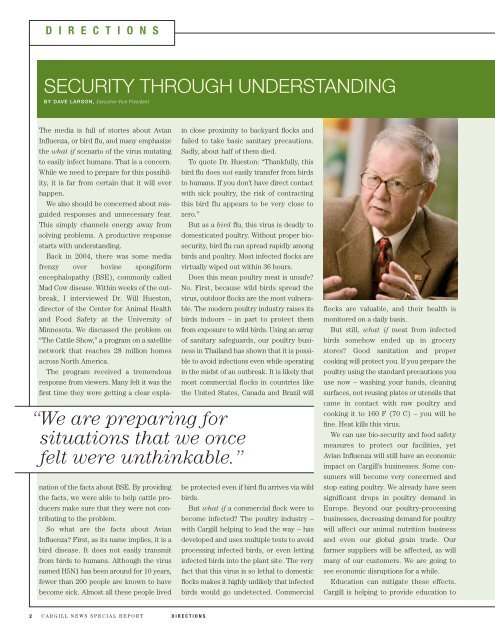Cargill Special Report - Cargill Meat Solutions
Cargill Special Report - Cargill Meat Solutions
Cargill Special Report - Cargill Meat Solutions
Create successful ePaper yourself
Turn your PDF publications into a flip-book with our unique Google optimized e-Paper software.
D I R E C T I O N S<br />
SECURITY THROUGH UNDERSTANDING<br />
BY DAVE LARSON, Executive Vice President<br />
The media is full of stories about Avian<br />
Influenza, or bird flu, and many emphasize<br />
the what if scenario of the virus mutating<br />
to easily infect humans. That is a concern.<br />
While we need to prepare for this possibility,<br />
it is far from certain that it will ever<br />
happen.<br />
We also should be concerned about misguided<br />
responses and unnecessary fear.<br />
This simply channels energy away from<br />
solving problems. A productive response<br />
starts with understanding.<br />
Back in 2004, there was some media<br />
frenzy over bovine spongiform<br />
encephalopathy (BSE), commonly called<br />
Mad Cow disease. Within weeks of the outbreak,<br />
I interviewed Dr. Will Hueston,<br />
director of the Center for Animal Health<br />
and Food Safety at the University of<br />
Minnesota. We discussed the problem on<br />
“The Cattle Show,” a program on a satellite<br />
network that reaches 28 million homes<br />
across North America.<br />
The program received a tremendous<br />
response from viewers. Many felt it was the<br />
first time they were getting a clear expla-<br />
nation of the facts about BSE. By providing<br />
the facts, we were able to help cattle producers<br />
make sure that they were not contributing<br />
to the problem.<br />
So what are the facts about Avian<br />
Influenza? First, as its name implies, it is a<br />
bird disease. It does not easily transmit<br />
from birds to humans. Although the virus<br />
named H5N1 has been around for 10 years,<br />
fewer than 200 people are known to have<br />
become sick. Almost all these people lived<br />
2 CARGILL NEWS SPECIAL REPORT DIRECTIONS<br />
in close proximity to backyard flocks and<br />
failed to take basic sanitary precautions.<br />
Sadly, about half of them died.<br />
To quote Dr. Hueston: “Thankfully, this<br />
bird flu does not easily transfer from birds<br />
to humans. If you don’t have direct contact<br />
with sick poultry, the risk of contracting<br />
this bird flu appears to be very close to<br />
zero.”<br />
But as a bird flu, this virus is deadly to<br />
domesticated poultry. Without proper biosecurity,<br />
bird flu can spread rapidly among<br />
birds and poultry. Most infected flocks are<br />
virtually wiped out within 36 hours.<br />
Does this mean poultry meat is unsafe?<br />
No. First, because wild birds spread the<br />
virus, outdoor flocks are the most vulnerable.<br />
The modern poultry industry raises its<br />
birds indoors – in part to protect them<br />
from exposure to wild birds. Using an array<br />
of sanitary safeguards, our poultry business<br />
in Thailand has shown that it is possible<br />
to avoid infections even while operating<br />
in the midst of an outbreak. It is likely that<br />
most commercial flocks in countries like<br />
the United States, Canada and Brazil will<br />
“We are preparing for<br />
situations that we once<br />
felt were unthinkable.”<br />
be protected even if bird flu arrives via wild<br />
birds.<br />
But what if a commercial flock were to<br />
become infected? The poultry industry –<br />
with <strong>Cargill</strong> helping to lead the way – has<br />
developed and uses multiple tests to avoid<br />
processing infected birds, or even letting<br />
infected birds into the plant site. The very<br />
fact that this virus is so lethal to domestic<br />
flocks makes it highly unlikely that infected<br />
birds would go undetected. Commercial<br />
flocks are valuable, and their health is<br />
monitored on a daily basis.<br />
But still, what if meat from infected<br />
birds somehow ended up in grocery<br />
stores? Good sanitation and proper<br />
cooking will protect you. If you prepare the<br />
poultry using the standard precautions you<br />
use now – washing your hands, cleaning<br />
surfaces, not reusing plates or utensils that<br />
came in contact with raw poultry and<br />
cooking it to 160 F (70 C) – you will be<br />
fine. Heat kills this virus.<br />
We can use bio-security and food safety<br />
measures to protect our facilities, yet<br />
Avian Influenza will still have an economic<br />
impact on <strong>Cargill</strong>’s businesses. Some consumers<br />
will become very concerned and<br />
stop eating poultry. We already have seen<br />
significant drops in poultry demand in<br />
Europe. Beyond our poultry-processing<br />
businesses, decreasing demand for poultry<br />
will affect our animal nutrition business<br />
and even our global grain trade. Our<br />
farmer suppliers will be affected, as will<br />
many of our customers. We are going to<br />
see economic disruptions for a while.<br />
Education can mitigate these effects.<br />
<strong>Cargill</strong> is helping to provide education to


